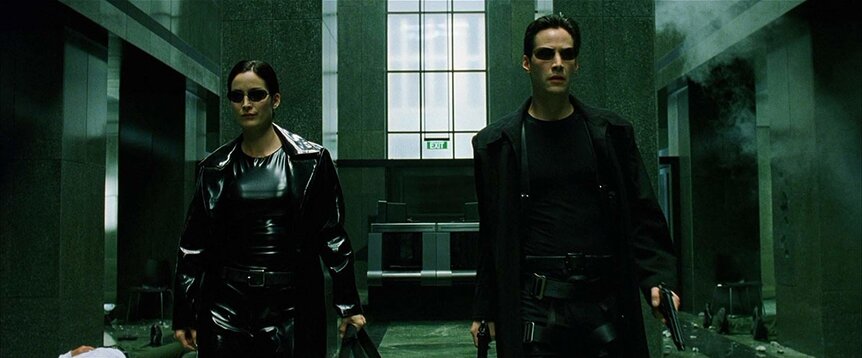Create a free profile to get unlimited access to exclusive videos, sweepstakes, and more!
How The Matrix has gone from men's rights dream to formative trans masterpiece

Call trans opt: received...
When you think of The Matrix, is your first thought about bullet time and Keanu Reeves, or is it about the red pill subreddit that has become synonymous with men's rights activism?
Lana and Lilly Wachowski's now 20-year-old science-fiction dystopia has become one of pop culture's most recognizable properties, and also one of its most polarizing. While undoubtedly incredibly influential for its action scenes and choreography, which fundamentally altered the look and rhythm of Hollywood action filmmaking, the Wachowskis have also managed to create one of the most amorphous fandoms in cinematic history. How did it get this way?
The film was my favorite movie for years when I was a young teenager, and I rewatched it over and over. The movie appealed to me as a technical marvel and because I was seduced by its ideas, its playful but sophisticated inquiries into spirituality, Marxism, technology, and postmodernism. Soon enough, though, I started to notice that the Matrix fandom seemed to be predominantly, suffocatingly, male, particularly once I began spending more time online. It quickly began to seem like a condescending, insular, and aggressive space that I no longer wanted anything to do with.
In 1999 and over the years since, The Matrix has been blamed for the Columbine massacre and other tragedies, propped up as a scapegoat for supposedly inspiring young people into violence through its highly stylized combat. On a broader scale, the fandom for the film was fiercely devoted to it, attached to the palatable and exciting version of the many ideas swirling around within it.
Culturally speaking, one concept really took off in a way that crystallized the complicated and confused reception to the film: Neo (Keanu Reeves) chooses the red pill, symbolizing the path of truth, and rejects the blue pill, representing the illusion of life on Earth. Men's rights advocates, for example, found something useful about this dichotomy, and began to identify themselves as red pillers — presenting themselves as men that have discovered the brutal truth of the genders and their expectations, the ways in which society is structured, they argue, to benefit women.
This association between The Matrix and these groups, ostensibly fans but certainly inspired by this idea of a bitter pill of truth and hidden reality, came to define the film's legacy during the later aughts. Soon enough, though, Lana Wachowski told the public that she was a transgender woman, and a few years later, Lilly also came out as a trans woman. While this in itself could have confused the poor MRA fans, and more importantly recontextualized the story of The Matrix, Lilly herself invited these reappraisals during her first public appearance following her coming out when she accepted a GLAAD Media Award.
"There's a critical eye being cast back on Lana and I's work through the lens of our transness," she said. "This is a cool thing, because it's an excellent reminder that art is never static. And while the ideas of identity and transformation are critical components in our work, the bedrock that all ideas rest upon is love." The Guardian even directly wondered if this would "turn off men's rights advocates."
Of course, these Matrix fans interpreted the film simplistically in the first place. The red pill/blue pill concept, to them, offered a way of describing the supposed secret that men are actually the ones being oppressed by women. Tangled up in this perspective on the film are the changes Neo undertakes after he chooses the red pill: in short, he becomes an inordinately cool killing machine, granted the ability to game the system and look badass while performing complex martial arts moves and ultimately learning that he is, literally, The One.
This journey of self-discovery for Neo appeals to MRAs because it helped to validate their misguided fantasies about the way of the world and what they can become. Ironically, this self-discovery narrative likewise captivates trans and genderqueer fans.
Scholar Cael M. Keegan recently published a book called Lana and Lilly Wachowski: Sensing Transgender, which chronicles their careers as developers of a trans aesthetic that transcends conventional notions of space, time, sex, race, and the disruptions of cinema and transness in parallel. In other words, the Wachowskis are responsible for helping us envision new realities, particularly as the most successful trans filmmakers in Hollywood. When The Matrix was included in TIFF's 1999 retrospective, "Movies at the Millennium," earlier this year, Keegan introduced it, saying:
"Trans communities have long pointed out how The Matrix's plot follows the sequence of dysphoria, identity realization, name change, hormonal therapy, surgery, and social reintegration as a new gender….The film's iconic red pill/blue pill scene replays the scenario of transgender diagnosis. The red pill stands in for the perceptually and physically transformative effects of hormone therapy, while Morpheus performs the clinical role of therapist, analyzing the transgender subject's sense that something is wrong with the world."
Putting aside whatever reactions the MRAs had to all this, what's far more interesting is to consider how, yes, these fans have always been around, but also that the shape of The Matrix's fandom has certainly changed with time. Non-traditional (ie. not cisgender men) fans show up all the time. Ilana Glazer breezed through the New York City streets in full Matrix cosplay in a recent episode of Broad City. Charli XCX and Troye Sivan did their own cosplay in the music video for "1999," and Natalie (Rebel Wilson) describes an alternate universe modeled after other romcoms as being "The Matrix for lonely women," in the recent romcom Isn't It Romantic.
These examples show how thoroughly the film has permeated popular culture, sure, but they are also illustrations of how The Matrix's fandom and cultural understanding has shifted over two decades (as Lilly said, art is never static), and how fandom is constantly in reconstruction and always partially informed by the viewer's identity. Our reactions to art are different in the moment, and new audiences can discover old art and also, thrillingly, new meanings. Near the end of his talk, Keegan wondered, "Did the Wachowskis make a secretly transgender film, or did this film make available new sensations that have led to changes in how we understand the possibilities of the body and of gender?"
While reckoning with and celebrating The Matrix's 20th anniversary, we should remember how it has influenced film and pop culture, but also use it as an invitation to reconsider our relationship to other things we love. Perhaps there's something new within it, waiting to be seen.



























